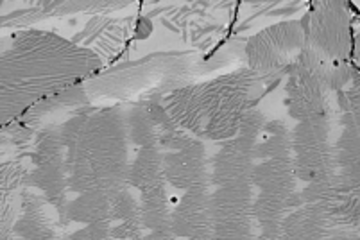All genres
81.
Talk
DFT study on field ion microscopy contrast. Invited Seminar, Rouen University, Rouen, France (2023)
82.
Talk
Charge corrections for electronic transitions at defects with ionic and electronic screening. Workshop "First-principles modeling of defects in solids: Charges meet lattices", Zürich, Switzerland (2022)
83.
Talk
Design and application of an ab initio electrochemical cell. virtual DPG-Frühjahrstagung (DPG Spring Meeting) of the Surface Science Division, Berlin, Germany (2021)
84.
Talk
Insights into processes at electrochemical solid/liquid interfaces from ab initio molecular dynamics simulations. TMS 2021 Meeting, delivered online, Orlando, FL, USA (2021)
85.
Talk
High-throughput optimization of finite temperature phase stabilities: Concepts and application. Coffee with Max Planck, virtual seminar organized by the MPIE, Düsseldorf, Germany (2021)
86.
Talk
High-throughput optimization of finite temperature phase stabilities: Concepts and application. Coffee with Max Planck, virtual seminar organized by the MPIE, Düsseldorf, Germany (2021)
87.
Talk
Chemistry and Structure at Lattice Defects studied at the Atomic Scale. 4th Symposium Core Research Cluster Materials Science & 3rd Symposium on International Joint Graduate Program in Materials Science, Tohoku University, online, Tohoku, Japan (2020)
88.
Talk
Chemistry at Lattice Defects Probed at Atomic Scale. 20th International Union of Materials Research Societies International Conference in Asia IUMRS, Perth, Australia (2019)
89.
Talk
Ab initio description of coupling phenomena between magnetic and structural degrees of freedom. EASTMAG2019 – VII Euro-Asian Symposium “Trends in Magnetism”, Jekaterinburg, Russia (2019)
90.
Talk
Atomic scale phase separation tendencies in nanostructured copper alloys. 26th International Symposium on Metastable, Amorphous and Nanostructured Materials 2019 (ISMANAM 2019), Chennai, India (2019)
91.
Talk
Modelling of charged point defects with density-functional theory. 4th International Workshop on Models and Data for Plasma-Material Interaction in Fusion Devices, National Institute for Fusion Science (NIFS), Toki, Japan (2019)
92.
Talk
Chemistry at Lattice Defects Probed at Atomic Scale. The 53rd Annual Meeting of the Israel Society for Microscopy, Tel Aviv, Israel, Tel Aviv, Israel (2019)
93.
Talk
Interaction of Chemistry and Structure at Lattice Defects at Atomic Scale. Russell Berrie Nanotechnology Institute, Technion, Haifa, Israel, Haifa, Israel (2019)
94.
Talk
Imaging single vacancies and atoms using joint FIM and APT experiments. Conference on Possibilities and Limitations of Quantitative Materials Modeling and Characterization, Bernkastel-Kues, Germany (2019)
95.
Talk
Chemistry and Structure of Lattice Defects. Physics Colloquium, Faculty of Physics, University Duisburg-Essen, Duisburg, Germany (2019)
96.
Talk
Concepts and algorithms in SPHInX. Weierstraß-Institut für Angewandte Analysis und Stochastik, Online Seminar, Berlin, Germany (2019)
97.
Talk
From Atomistic Understanding to Engineering Design of Advanced Medium and High Manganese Steels. 4th International Conference on medium and high Manganese steels, Aachen, Germany (2019)
98.
Talk
Field evaporation from a density-functional theory perspective. University Stuttgart, Online Seminar, Stuttgart, Germany (2019)
99.
Talk
Segregation and Transformation at Lattice Defects as Microstructure Design Toolbox. Materials Science and Engineering Congress, Darmstadt, Germany (2018)
100.
Talk
Density-functional modelling of field evaporation. Atom probe tomography and microscopy conference 2018, Gaithersburg, MD, USA (2018)











